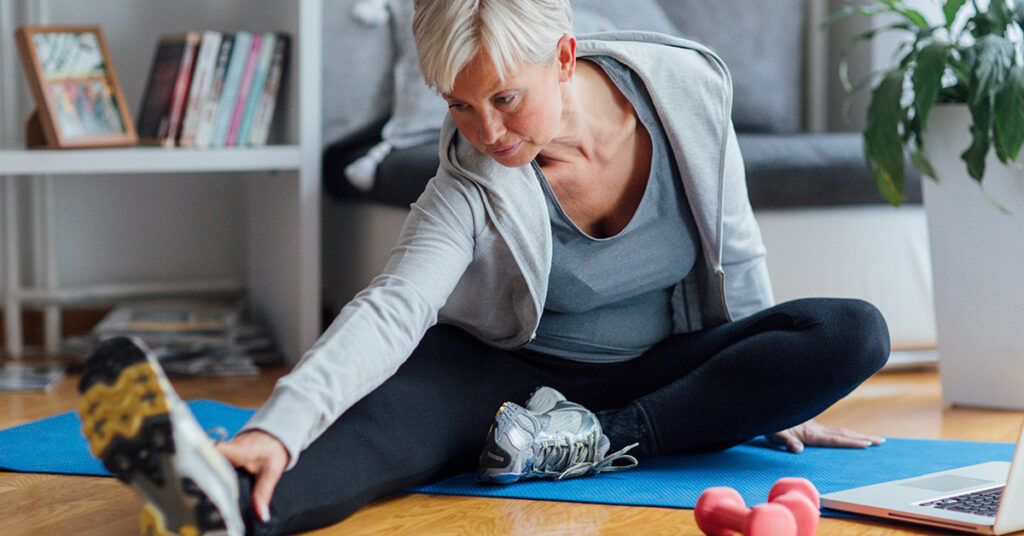
One of the many benefits of exercise is how it boosts your mood and reduces stress. With stress and anxiety levels at an all-time high these days, getting more exercise is one of the best things you can do for your health.
Making exercises for seniors a part of your daily routine will also lower your risk of falling, improve cognitive function and reduce your risk of dementia. In addition, regular exercise will dramatically cut your risk of heart disease, stroke, diabetes and cancer. It might even help you sleep better.
On top of all that, daily exercise can help you stay active and independent for years to come. And that’s a much more attractive outcome than letting yourself slide into decrepit old age. We don’t want that for you and neither do you.
But what if the gym is closed?
You don’t need a gym or special equipment to build strength, endurance and flexibility. All you need is your own body weight. You can add dumbbells and resistance bands later once you’ve got into the groove and realize how much better you feel when you make exercise a priority.
To help you get started, here are seven at-home exercises for seniors. Go slow and focus on proper form to get the most benefit.
- Tandem Stance
This is commonly used as a test for assessing balance. It’s also a great exercise to do every day, because it can significantly improve balance and decrease the risk of falls.
How to do it: Stand tall with your feet together, and brace your core. From here — holding onto a wall, counter, or sturdy chair for balance, if necessary — step one foot in front of you so that your front foot’s heel is against your back foot’s toes. Your feet should be in a straight line. Imagine you’re standing on a tightrope or balance beam. Hold this position for 30 seconds or as long as you can, then switch the position of your feet and repeat.
Make it harder: First, step into the tandem stance without using a wall for balance. Once you’ve mastered that, perform the exercise while holding a light weight in each hand. Don’t have dumbbells at home? Use water bottles or cans of food.
- Single-leg Stand
Falls are the number one cause of injury among older adults, so simple at-home exercises for seniors like standing on one foot and heel raises can make you steadier on your feet.
How to do it: Stand tall with your feet together, and brace your core. From here — holding onto a wall, counter, or sturdy chair for balance, if necessary — lift your right foot just off the floor so you’re standing on your left foot. Imagine a string through the crown of your head is pulling your spine straight toward the ceiling, and engage your core to avoid leaning to one side. Hold this position for 30 seconds or as long as you can, then repeat on the opposite side.
Make it harder: While holding the position, slowly point your lifted foot out in front of you, to the side, and then straight behind you. Repeat for the duration of the exercise.
- Sit-to-Stand
Do 2 to 3 sets of 8 to 12 reps.
Getting in and out of chairs, bending down to pick something up, or using the bathroom all involve squatting movements. Doing this exercise will make those activities easier.
How to do it: Stand tall with your feet shoulder-to-hip-width apart. Hold your arms straight out in front of you at shoulder level and brace your core. This is your starting position.
From here, push your hips back, and bend your knees to slowly lower your body into a squat, not letting your knees cave in as you do so. Pause, then push through your heels to slowly return to your starting position.
If a bodyweight squat is too challenging, start your squat from a seated position.
If your knee hurts when you squat, start from a seated position and push up just a couple of inches. Once you feel some tension, release to sit back down. Even with this small range of motion, you’ll still build strength in your legs, hips and core.
- Wall Pushups
Do 2 to 3 sets of 8 to 12 reps.
The pushup works your chest, shoulders, arms and back. It also strengthens your core, quads and glutes. Done correctly, doing pushups will help you with everyday tasks such as pushing grocery carts, lifting grandchildren and maintaining good posture.
How to do it: Stand facing a wall, countertop or heavy table. The more upright you are, the easier the exercise. Place your hands on the edge, slightly wider than shoulder-width apart. Move your feet back until you’re at a comfortable angle, keeping arms straight and perpendicular to your body.
Slowly lower your chest forward, pause, and then press back up to straighten your arms. Keep your body straight throughout the entire movement, making sure to engage your abs and squeeze your butt. That’s one rep.
Make it harder: You can work your way up from pushups against the wall to pushups while resting on your knees, to full-on regular pushups.
- Knee-to-Chest
Hold for 10 to 30 seconds per side.
Stretching exercises for seniors can help reduce pain and prevent injury. This exercise stretches your glutes as well as your entire back.
How to do it: Lie on a mat with your legs straight. If that’s uncomfortable, bend both knees, and rest your feet on the mat.
Keeping your upper body down, lift your right knee toward your chest as far as comfortable. Gently grasp the back of your thigh to draw your leg closer to your chest. Hold for 10 to 30 seconds. Release, switch legs, repeat.
To come out of the pose, sit up slowly, gently rolling to your side first if needed. Check that you feel steady before standing up.
- Glute Bridge
Do 2 to 3 sets of 8 to 12 reps
This is a great exercise for strengthening your glutes, hips and hamstrings. It also activates your abdominal muscles and lower back to keep your body stable, so it doubles as a great core exercise. Strengthening these muscles will help you walk and climb stairs, maintain balance, and ease hip or back pain.
How to do it: Lie on your back with knees bent, feet flat on the floor about hip-width apart and heels a few inches away from your buttocks. Press your arms into the floor for support and brace your core to minimize the arch in your lower back.
From here, push through your heels and squeeze your glutes to lift your hips up until your body forms a straight line from your knees to shoulders. As you get stronger, focus on getting your shins as close to vertical as you comfortably can at the top of the movement. Pause, then slowly lower your hips to return to starting position.
- Bird Dog
Do 2 to 3 sets of 6 to 8 reps.
The bird dog helps strengthen your glutes, hips, abdominals, and deep core muscles that support your spine. A strong core can make just about everything you do easier, including walking, standing, sitting down, and rolling over in bed.
How to do it: Start on all fours with your hands below shoulders and knees below hips. Engage your abs, keep your spine neutral, and gaze down or slightly forward.
Lift your left arm and extend your right leg until they’re in line with the rest of your body. Pause, then lower back down, and repeat on the opposite side with right arm and left leg extended. That’s one rep.
Make it easier: Try raising only one arm or one leg at a time, and gradually build up to where you can hold both out, even if they’re only partially held out.
Make aerobic exercise part of your routine.
You don’t need a treadmill or elliptical machine to get a good cardio workout in. You can go for a brisk walk, march in place, or go up and down stairs. If you have access to a pool, swimming is a great way to improve cardiovascular health. It’s easy on your joints and you won’t get overheated in the pool as you would jogging or biking during the summer months in Arizona.
How much cardio do you need?
The American Heart Association recommends older adults get 2½ hours of moderate-intensity aerobic activity a week. (That’s five 30-minute sessions a week.) But if that’s too much, do what you can and follow your doctor’s advice.
More home exercises to get you started.
- Join a group fitness class with exercise videos for seniors from the National Institute on Aging.
- A 6-minute strength routine, stretches and balance exercises for seniors you can do at home.
Our Retirement Community Makes Exercise Fun!
Key to maintaining an active lifestyle is making exercise enjoyable. After all, if you don’t like it, exercising can quickly become a chore rather than a joy. That’s where our fitness instructors can help. Whether you’re tuning in to fitness classes on our in-house TV channels or joining a group exercise class in our fitness center or swimming pool (when it’s safe to do so), our fitness instructors will help you reach your goals with a smile on your face. It’s all part of our holistic approach to wellness designed to support active aging.
To learn more about our vibrant lifestyle, explore the services and amenities that make life a joy at Friendship Village Tempe.

